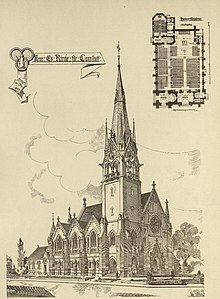Richard Böklen
Richard Böklen (born January 31, 1861 in Sulz am Neckar ; † August 26, 1934 in Stuttgart ) was a German architect , Württemberg construction clerk and university professor .
Life
Richard Böklen's father was the mathematician Otto Böklen, director of the Realanstalt in Reutlingen. From 1878 to 1881 he completed his studies at the Königlich Württembergische Baugewerkschule Stuttgart (today's Hochschule für Technik Stuttgart ) under Joseph von Egle . He also did internships in Tübingen and St. Gallen in Switzerland. During his studies, he became in 1880 member of the Stuttgart singers shaft Schwaben . In 1889 he went on a study trip to Italy.
After 1889, Richard Böklen went to Ernst von Ihne in Berlin , where he worked, among other things, on the construction of the Friedrichshof Palace , the renovation of the Berlin Palace and the competition design for the Kaiser Wilhelm National Monument. During this time he met Carl Feil, with whom he opened a joint architecture office in Stuttgart's Eberhardstrasse in 1895 (as the “Bureau for Architecture and Applied Arts”).
In 1893 he married the pharmacist's daughter Gertrud Finckh from Reutlingen, the sister of the poet Ludwig Finckh . One of the two daughters was the painter Hilde Böklen .
In 1896 Richard Böklen was employed as a government master builder ( assessor in the state building administration) at the Royal Domain Directorate in Stuttgart.
In 1901 he was appointed professor at the Stuttgart building trade school.
As a freelance architect (together with Carl Feil ) as well as a professor at the building trade school in Stuttgart, Richard Böklen built a total of seven churches in Württemberg, including the Luther Church in Cannstatt, as well as workers' settlements in Stuttgart. One of his students was Gustav Epple, who later founded the Epple construction company.
At the end of the 1920s, the Böklen and Feil office was closed, so that Böklen only devoted himself to his work as a lecturer. In 1930 he ended his career and went into retirement.
He died in Stuttgart on August 26, 1934 at the age of 73.
plant
buildings
- based on historical sources (excerpt)
- Ev. St. Ulrich church in Pflugfelden (new building 1902–1903)
- Ev. Parish church of St. Martin in Weil im Schönbuch (renovation and renewal in 1904)
- Ev. Christ Church in Großeislingen (new building 1905–1906)
- Ev. Notzingen Church (Oberamt Kirchheim u. T.) (reconstruction, tower and community hall newly added 1905–1906)
- Ev. Church in Salach (Oberamt Göppingen) (reconstruction and renovation 1906)
- Parish and parish house of the Gedächtniskirche in Stuttgart (conversion and extension 1906)
- Ev. Mauritius Church in Reichenbach an der Fils (partially new building 1906–1907)
- Ev. Church in Tailfingen (Oberamt Balingen) (new building 1906–1907)
- Rectory in Tailfingen (Oberamt Balingen) (new building 1906–1907)
- Rectory in Sontheim (new building 1907–1908)
- Ev. Church in Babstadt (Baden) (conversions and extensions, built 1908–1909)
- Parish hall in Gussenstadt (Oberamt Heidenheim) (project 1910)
- Ev. Church in Gündelbach (Oberamt Maulbronn) (reconstruction and renewal 1910)
- Ev. Martinskirche in ( Straubenhardt -) Conweiler (new building 1911–1912)
- Ev. Church in (Aalen-) Unterrombach (new building 1911–1912)
- Ev. Church in Hedelfingen (designed in 1913)
- Ev. Church in Maienfels (new tower and renovation 1914–1915)
- Ev. Michaelskirche Stuttgart-Wangen (conversion and renewal in 1903) (together with Carl Feil)
- according to more recent sources (excerpt)
- Ev. Luther Church in Stuttgart-Bad Cannstatt (renovation 1897–1900)
- (Old) Villa Haux in (Albstadt-) Ebingen (new facade and pavilion extension 1898)
- Cemetery chapel in (Albstadt-) Ebingen (new building 1898–1899)
- own studio and residential building at Arminstrasse 13 in Stuttgart-Heslach (new building 1898–1899)
- Residential development Kolonie Ostheim, Kanonenweg 185–191 (new building 1900–1901)
- Residential development Kolonie Ostheim, Raitelsbergstrasse 21–39 (new building 1901–1902)
- Residential development Kolonie Westheim in Stuttgart-Botnang (new building 1902–1903)
- Oberamtssparkasse in Balingen (new building 1902–1903)
- Ev. Peterskirche in (Albstadt-) Tailfingen (renovation 1905)
- Ev. Pauluskirche in (Albstadt-) Tailfingen (new building 1906–1907)
- Ev. Leonhard Church in Stuttgart (renovation 1907)
- Villa Daniel-Groz in (Albstadt-) Ebingen (new building 1907–1908)
- Ackermannstift in Sontheim (1907–1909)
- New Villa Haux in (Albstadt-) Ebingen (new building 1908–1909)
- Ev. Matthäuskirche in Stuttgart (renovation 1910)
- Franz Schubert School in the Westheim residential colony (new building 1912)
Fonts
- The newer buildings of the association for the welfare of the working classes in Ostheim and Westheim. In: Monthly publication of the Württembg. Association for construction in Stuttgart. F. Weise's Hofbuchhandlung in Stuttgart (until 1900); South German Verl.-Anstalt, Munich (from 1901). Stuttgart 1898-1904, pp. 18-21. ( uni-stuttgart.de ).
Web links
- Works by Richard Böklen in the digital collections of the Stuttgart University Library ( uni-stuttgart.de )
literature
- Julius Baum : Böklen, Richard . In: Ulrich Thieme , Felix Becker (Hrsg.): General Lexicon of Fine Artists from Antiquity to the Present . Founded by Ulrich Thieme and Felix Becker. tape 4 : Bida – Brevoort . Wilhelm Engelmann, Leipzig 1910, p. 198 ( Textarchiv - Internet Archive ).
- Gerhard Penck: The fantastic history of the mansions of Friedrich Haux. Wasmuth, Tübingen / Berlin 2008, ISBN 978-3-8030-0683-7 .
- Kurt Schuler: An unjustifiably forgotten Sulzer: Richard Böklen. In: Sulzer newspaper. October 28, 1981.
Unpublished Sources
- Estate of the Böklen family, Stuttgart
Individual evidence
- ↑ Paul Meißner (Ed.): Alt-Herren-Directory of the German Singers. Leipzig 1934, p. 237.
| personal data | |
|---|---|
| SURNAME | Böklen, Richard |
| BRIEF DESCRIPTION | German architect, Württemberg construction clerk and university professor |
| DATE OF BIRTH | January 31, 1861 |
| PLACE OF BIRTH | Sulz am Neckar |
| DATE OF DEATH | August 26, 1934 |
| Place of death | Stuttgart |
